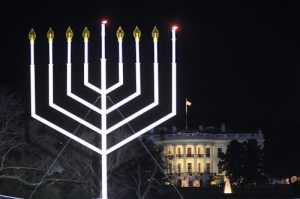Miketz – Chanukah 2019: Ah Lichtiger Chanukah
by devadmin | December 26, 2019 7:21 pm
We begin the special Shabbis Chanukah edition with another mazel tov shoutout to Ziona Isaacs who married Norman Greenberg this past Sunday evening.
Mazel tov to our friends Doba and Kalman Isaacs and their extended family. Mazel tov as well to the extended Greenberg family, who had the merit of having grandfathers and great-grandfathers in attendance. Special mazel tov to Mrs. Miriam Treitel, Ziona’s grandmother.
Ah Lichtiger Chanukah:
In this week’s parsha of Miketz, Yoisef will -after 12 years- be released from jail, correctly interpret Paroy’s dreams, be appointed viceroy of Egypt, marry Osnas the daughter Poitifera who some say was originally called Potifar but had a name change following his emasculation. This may have occurred –so says the medrish- after making homosexual advances towards Yoisef. As an aside, not a giferliche model to follow; wayward rebbes beware, one day an angry father might just walk in and tamper with your junk, if you chap. Yoisef will have two boys with Osnas who may or may not have been the daughter of Dina who conceived following a rape by hands –and other parts- of Shechem, chazir that he was. Yoisef’s brothers –sans little brother Binyomin- will be sent by their father down to Egypt to buy food where they will encounter but not recognize him Yoisef. He will zicher remember them, how could he forget? Let’s recall how the holy brothers traumatized him. Somewhere in the parsha, brother Shimon he of the infamous Shimon and Levi sword slinging duo, will be arrested and held, as will –by the end of the parsha, little brother Binyoimin. A good part of Miketz revolves around the cat and mouse games being played by Yoisef on his brothers, and the emes is, who can blame him? Payback is a bitch, so is revenge. They planned to kill him, stripped him of his famous tunic, fed him to snakes and scorpions –Rashi says the pit they threw him into had both- and sold him into slavery. For what? For twenty silver coins. And they did what with the silver? Medrish tells us they each bought shoes. Ten brothers each got a pair for two silver coins. Shoin, two dollars shoes are long gone as any of your wives and or, significant others can attest. How all, or any of these amazing tales were possible, only the medrish can figure out, ober all that has previously been covered by the heylige Oisvorfer in prior postings. Go back and check out the archives at www.oisvorfer.com. The heylige Toirah will keep us all in suspense until next shabbis (the Oisvorfer’s bar mitzvah parsha) with the great reveal, some say also literally when Yoisef will pull down his hoizen (pants), show off his bris and prove by his shortcomings, if you chap, that his royal scepter is in fact Jewish. This week in honor of Shabbis Chanukah, the Oisvorfer will – for the first time in ten years- skip over the parsha and shine a shtikel light on “pirsumai nisa,” the mitzvah on Chanukah to publicize the great miracle which gave birth to the Yom Tov of Chanukah. Let’s look at the bright side as we examine the significance of lights and how the Yom Tov of Chanukah has evolved to where in our times –bazman hazeh mamish- chasidim, misnagdim, fully observant and not, are finding creative outlets to show off their inner Jew, while also performing one of the very few mitzvis associated with Chanukah. Times have certainly changed.
Growing up in a Yiddish only, and later on, predominantly Yiddish speaking home, when it came to greeting each other on Chanukah, our few relatives and even friends did so, primarily by wishing each other “ah freylichin Chanukah,” meaning a cheerful Chanukah. As an aside the Oisvorfer continued speaking Yiddish to his parents until they passed. In other homes, and even in our own, at times we would instead hear “ah lichtiger chanukah,” which when literally translated means, a bright, or brilliant and luminous Chanukah.
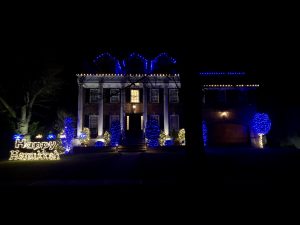 Grada the expression “ah lichtiger Chanukah” was on the Oisvorfer’s mind this past Sunday night, the first night of Chanukah on the way back from the very spirited Isaac’s wedding (Ziona Isaacs married Norman Greenberg, mazel tov to the entire Isaacs and Greenberg families again), while driving a chaver home to Muriel Ave here in Lawrence New York. What happened on Muriel Avenue? As he drove up the block, one house stood out amongst the others; it was bright, luminous, and quite beautiful. It was fully adorned and illuminated in Christmas-style (shoin I said the word, so shoot me), holiday lights, ober this house had the Chanukah blue and white colors, along with well lit signage wishing all a Happy Chanukah. Trees and bushes were now dressed up in Chanukah motif. Seeing the house evoked other good memories. It was lichtig mamish!
Grada the expression “ah lichtiger Chanukah” was on the Oisvorfer’s mind this past Sunday night, the first night of Chanukah on the way back from the very spirited Isaac’s wedding (Ziona Isaacs married Norman Greenberg, mazel tov to the entire Isaacs and Greenberg families again), while driving a chaver home to Muriel Ave here in Lawrence New York. What happened on Muriel Avenue? As he drove up the block, one house stood out amongst the others; it was bright, luminous, and quite beautiful. It was fully adorned and illuminated in Christmas-style (shoin I said the word, so shoot me), holiday lights, ober this house had the Chanukah blue and white colors, along with well lit signage wishing all a Happy Chanukah. Trees and bushes were now dressed up in Chanukah motif. Seeing the house evoked other good memories. It was lichtig mamish!
For many years when the kids were younger, we would, after visiting the grandparents in Boro Park, make our way back home through Belle Harbor. Why? Because Bell Harbor, or at least certain blocks in Belle Harbor, had a good of number of homes that were very well dressed up for Christmas. Santas, lights, wreaths, and galloping lawn ornaments fill the streets. And guess what? These displays were quite pleasing to the eye. And while the kids didn’t long for Santa -they got more than their fill of presents over Chanukah- they, including us, did envy the display. Though we Yiddin don’t avada believe in the entire Christmas zach- it’s avoido zoro mamish, still one could appreciate the magnificent lights, the displays, and the work that went into decorating these homes. These goyim were good! And all this before the advent of the LED bulbs. The goyim were exhibiting their version of pirsumai nisa- azoy vi es darft tzu zeyn (the way it should be)? And us? What is pirsumai nisa?
Shoin, here we are and it’s kimat 2020. The kids are all grown up, ober es kittzeld zich (the Oisvorfer still has a hankering) to visit Bell harbor, and just the other night, one suggested we drive by. And taka the Oisvorfer used to wonder to himself azoy: if these goyim are doing their utmost to show off their holiday, why aren’t we Yiddin who are commanded on Chanukah to perform the mitzvah of pirsumai nisa (publicizing of the miracle) doing so? Are our Chanukah lights –no matter how many menorahs are being lit in any particular home- not being drowned out and overshadowed by the goyim who happen to be celebrating their own holidays with lights? Should we not be doing more pisrumay nisa? They are! Shouldn’t we, during the festival of lights be displaying more of them??
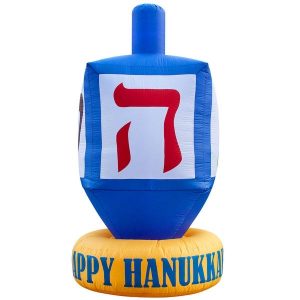 In any event, the house on Muriel Avenue and a few other displays the Oisvorfer has passed these last few days and nights, got him thinking azoy: is it kosher –in addition to the lights of our menorahs- to also dress up our houses with Chanukah themed displays? Is it ok for us to emulate the goyim with our form of holiday displays? What did our sages of yore have to say about this? And the answer: nothing! They said nothing at all. At least not yet. Why not? Ver veyst? Accordingly, says the Oisvorfer azoy: why not? And taka in very recent years, Chinese manufacturers (aren’t they somehow involved in kimat every Jewish holiday) inspired mistama by Toirah inspired entrepreneurs, have been manufacturing huge inflatable dreidles, menorah’s and other Chanukah themed displays. Givaldig and lichtig!
In any event, the house on Muriel Avenue and a few other displays the Oisvorfer has passed these last few days and nights, got him thinking azoy: is it kosher –in addition to the lights of our menorahs- to also dress up our houses with Chanukah themed displays? Is it ok for us to emulate the goyim with our form of holiday displays? What did our sages of yore have to say about this? And the answer: nothing! They said nothing at all. At least not yet. Why not? Ver veyst? Accordingly, says the Oisvorfer azoy: why not? And taka in very recent years, Chinese manufacturers (aren’t they somehow involved in kimat every Jewish holiday) inspired mistama by Toirah inspired entrepreneurs, have been manufacturing huge inflatable dreidles, menorah’s and other Chanukah themed displays. Givaldig and lichtig!
How is taka shayich (remotely possible) that our rabbis are quiet in this subject? Don’t they typically chime in on all matters Jewish? Is it efsher because when Chanukah was first enacted, there were no decorative items to display? Then again, that never stopped rabbis from enacting new gizayris (proclamations prohibiting something) to keep up with the times. As you well know, there is zicher no mention of Chanukah, a holiday all seem to enjoy, anywhere in the heylige Toirah. That too never stopped anyone from adding new prohibitions. Why isn’t Chanukah mentioned in the heylige Toirah? It’s quite simple: the story had yet to take place. And what about the heylige Gemora? Didn’t Chanukah take place during the times the Gemora was being redacted? And, doesn’t everything appear in the Gemora? Didn’t your rebbe – when not making moves on you- teach you that everything in this world is found in the heylige Gemora? He did: The heylige Gemora -as you should well know had you paid any attention in class- has tractates named after the heylige shabbis and each Yom Tov, yet there is no such volume for Chanukah. In fact, there is scant mention of Chanukah at all in the entire heylige Gemora. Why? Shoin all that for another day but among the reasons is this one: our sages weren’t’ very enamored with the Chashmonoim, the Macabess, the good guy fighters who took on the Greeks army and defeated them.
Why do we bother with placing our menorah’s near a window? Nu, in yeshiva we were taught various laws regarding the time slot for lighting, and for the menorah’s placement; in the end, it appears that most of these laws were related to the mitzvah of “pirsumai nisa,” publicizing the miracle of Chanukah. The idea is for people who pass by on their way to and from wherever, to observe the menorah in our windows and recall the great miracles of Chanukah. Though the mitzvah of pirsumai nisa is also closely associated with the great miracles of Purim and others –hec, isn’t life itself one big miracle, it so happens that whenever we hear the phrase “pirsumei nisa,” we immediately associate those two words with the lighting of our menorahs. In fact, the hour of lighting the menorah was determined by our Sages as right around twilight because it would be most effective at publicizing the mitzvah as many people are moving about at that hour coming home from work or finishing up their shopping. Moreover, from the times of the Chashminoim (Judah Macabee and his gang) who waged battle against the Greeks (and miraculously defeated them), or shortly thereafter –it’s a machloikes of course- up until, and including our days, the lighting of our menorahs – also known as chanukias- has been the most paradigmatic example of a commandment whose main purpose is to spread a miracle.
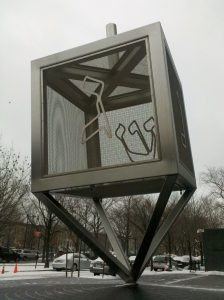 Ober what exactly is pirsumai nisa? In plain English it means azoy: the obligation to publically commemorate the miracle of Chanukah, which we fulfill by lighting our menorahs with either oil or candles and placing them in a window with a view to the public sphere. Over in Israel, many place them outside opposite their mezuzahs for the same reason. Pirsumai nisa is the frequently repeated Talmudic phrase for what we do on Chanukah. In modern Hebrew, the very word “pirsomet” means an advertisement. Pirsumai nisa is the guiding principle of many Chanukah practices. The central religious purpose of Chanukah is to let as many people as possible know the miracles of the festival, the miracle of Jewish survival in general and the miracles of God’s hidden presence in the world.
Ober what exactly is pirsumai nisa? In plain English it means azoy: the obligation to publically commemorate the miracle of Chanukah, which we fulfill by lighting our menorahs with either oil or candles and placing them in a window with a view to the public sphere. Over in Israel, many place them outside opposite their mezuzahs for the same reason. Pirsumai nisa is the frequently repeated Talmudic phrase for what we do on Chanukah. In modern Hebrew, the very word “pirsomet” means an advertisement. Pirsumai nisa is the guiding principle of many Chanukah practices. The central religious purpose of Chanukah is to let as many people as possible know the miracles of the festival, the miracle of Jewish survival in general and the miracles of God’s hidden presence in the world.
Ober, to whom are we doing this publicizing? Is it meant for our Jewish neighbors only? Or, also for the goyim? Who is the target pirsumai nisa audience? And like all else in our glorious religion and practice, the answer seemingly depends on who is being asked the questions. Says the RambaM (fourth chapter Hilchos Chanuka, Halacha 12), azoy: a destitute individual is required to sell his clothes to enable himself to kindle a menorah. He utilizes the phraseology “to announce (lehodia) the miracle”. The Rambam relies upon an explicit Gemora (Shabbis (23b) which tells us that kindling the lights of Chanukah takes precedence over reciting Kiddush with wine on Shabbis. Says the Magid Mishneh: A destitute individual is required to sell his clothes in order to acquire four cups of wine for the Pesach seder; certainly, that is the case in relation to Chanukah. Ober, weren’t we taught that a person is generally exempt from fulfilling a mitzva if it will cost more than twenty percent of his assets to fulfill it? We were. Ober, the Rambam writes that even if a person is penniless, he must spend any money he possesses to acquire the materials needed to kindle Chanukah lights. Standard mitzvos do not require these extraordinary measures, ober pirsumei nissa does. Shoin! Ober to whom are we publicizing?
Said Rav Moshe Feinstein: it is clear that we are publicizing the miracle of Chanukah to our fellow Yiddin. Moreover, he believed that if one publicizes the miracle to non-Jews only, aka: the goyim, one does not fulfill the mitzva of pirsumai nisa. Ober, said Rav Shimon Sofer, azoy: a person who lives among non-Jews should certainly light outside in order to publicize the miracle, as we are interested in publicizing the greatness of the RBSO to goyim as well. And says the Sefer HaNiar: there is pirsumai nisa for goyim. In fact, there are several other sources who disagree with Rav Moishe Feinstein. A few point to a posik from the Novee (Yichezkel 38:23) which says azoy: “Thus will I magnify Myself, and sanctify Myself, and I will make Myself known in the eyes of many nations; and they shall know that I am Hashem.” The many nations are the goyim! Shoin.
All that being said, until what time in the evening are we obligated to do pirsumai nisa? Says the heylige Gemora (Shabbis 21b): we leave the candles burning “ad shetichleh regel min ha-shuk” – until the public streets are empty of wayfarers. Who are these wayfarers the Gemora refers to? Said Rashi on this shtikel Gemora, azoy: the wayfarers being alluded to are “Tarmodians” – non-Jews who would stay late in the marketplace selling firewood to people as they went home. Seemingly, Rashi supports the idea of pirsumai nisa applying to non-Jews as well.
Shoin, there you have it, one question and several opinions. Ober, in the end, the debate may depend only how we translate the word “Tarmudai” as it appears in the verse quoted above. In response to the question up until when may a person light his candles, the heylige Gemora explains that the Chanukah licht (oil and or candles) may be lit each night until there is no more Tarmudai traffic in the street. Ober what does Tarmudai mean? Are they a nation that gathers thin wood, as Rashi explains, or are they a subgroup of Jewish people?
Says Rashi: Tarmudai refers to a people who gathered wood. They wait until people go home and light their fires. When the people run out of firewood, they go back to the “late” market to get some more wood from the Tarmudai people. Seemingly the Tarmudai were efsher an early version of the modern day Pakistani Open 24/7 convenience store, or efsher the original no-name 24/7 overpriced convenience stores where many of you stopped off to buy some magazine in a brown paper bag, if you chap. Interestingly enough, those late night stops were also for wood related purposes, if you chap. The point being made by Rashi is that the Tarmudai people were not Jewish. The bottom line: if you hold like Rashi, the mitzvah of pirsumai nisa applies to the goyim as well as Yiddin. Does everyone agree? Of course not and says The Rif (Shabbos, page 9 in the Rif’s pagination),azoy: the Tardumia people were in fact Jewish. Ober what about the posik above which told us that we may light candles until the Tarmudians are no longer on the streets? Not an issue: says he azoy: Tarmudia refers not to people but to wood. Accordingly, the collectors of the Tarmudai wood are called Tarmudaim. In other words: the obligation of pirsumai nisa is only Jew to Jew.
On the other hand, says the L’horos Nosson (Vol. IV #63) and also at least one other prominent rabbis azoy: it could very well be that Rashi knew that they were gentiles, but still may hold that pirsumai nisa applies only to Jews. And it could also very well be that the Rif just happen to know that they were Jewish, but he could be of the opinion that pirsumai nisa also applies to gentiles. Oy vey! It could be that when the Tarmudaim are still around to sell the wood, the Jewish customers are still around looking to be the buyers. And the bottom line: each rabbi held his own position and did not fold. Rav Moishe Feinstein held that there is no pirsumai nisa for goyim, but other prominent authorities held farkert.
The final bottom lines: many mitzvah celebrations have evolved over the years, and Chanukah, considered by or sages to be but a minor holiday, is no exception. Kimat every holiday has undergone change and broadening of its observance in the course of Jewish history — and in most cases, this included the incorporation of influences and traditions from non-Jewish sources. Purim shalach monos baskets no longer resemble what is described in the Migilah and is certainly different than the plate of cake and fruit your mom sent you out with for delivery. Today’s baskets are magnificent and cost a small or medium size fortune. As well, Pesach is rarely celebrated as described in the heylige Toirah. Was Pesach meant to be observed poolside? At a ski slope? Do you think the RBSO had elaborate and themed based smorgasbords in mind? Every Jewish holiday has changed. Why? Ershtens, Yiddin have more money. Secondly, Toirah inspired entrepreneurs who are versed in the pisukim and medrish, created new products. And where new products and services appear, there are well heeled Yiddin ready to buy them. And finally, larger Chanukah displays, including inflatable Chanukias, dreidels and colorful lights have appeared; let’s embrace them as there is no going back. It could be argued that new technology –not that inflatable dreidels and menorahs require advances in rocket science, have gotten more Yiddin involved with Chanukah observance and specifically with the mitzvah of pirsumai nisa.
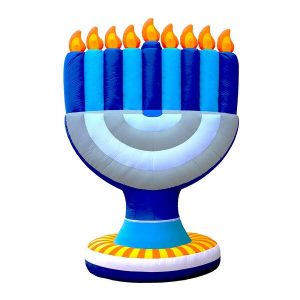 And in times when acts of anti-Semitism are proliferating all over the world and even close to home, too close for comfort, efsher we should embrace all those – frum and not- who find their own ways to creatively engage with the Chanukah holiday observance; why not?
And in times when acts of anti-Semitism are proliferating all over the world and even close to home, too close for comfort, efsher we should embrace all those – frum and not- who find their own ways to creatively engage with the Chanukah holiday observance; why not?
As an aside in 2013, Chabad planned 15,000 public menorah lighting events across the globe. By 2019, the number has certainly increased. They are certainly doing their part to perform the mitzvah of pirsumai nisa.
A lichtiger and a freylichin Chanukah, a gittin Shabbos Chanukah, and Choidesh Teves
The Heylige Oisvorfer Ruv
Yitz Grossman
Source URL: https://oisvorfer.com/miketz-chanukah-2019-ah-lichtiger-chanukah/
